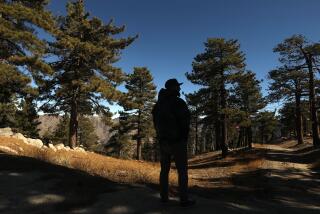Days of Tranquility Appear Numbered for Mountain Park
One of the state’s newest park acquisitions, in the Santa Monica Mountains just above Studio City, is soon to be turned over to the National Park Service and, presumably, to a host of new visitors drawn by added facilities that are almost sure to come.
The relatively pristine parcel is Wilacre Park, wooded and meadowed and not without its legends.
If you stand at the corner of Laurel Canyon Boulevard and Fryman Road and turn your back on the city, Wilacre Park lies before you.
Coyotes, Too
A narrow old road winds steeply up through woods to a grassy plateau. Canopies of oaks and pepper trees shade the road. The air is scented with sage and mint. Coyotes cross the trail.
It’s less than a mile to a lush meadow. From the northern rim a clear view over the Valley opens up.
At the turn of the century, a Frenchman ran sheep on land that is now Wilacre Park. When he died, some of the land was bought by Jules Viole, a downtown pharmacist, who used it for a summer home. Viole’s daughter and grandson still live on 14 acres of the land he bought, at the corner of Fryman Road and Iredell Street.
Story Acquisition
Among the visitors to the Viole spread was Gen. Walter P. Story, who soon bought an adjacent parcel. The general was married to artist Lorenza Larzerini, and the Storys lived in style, building an elaborate house next to the present park’s entrance, hosting parties and cultural performances.
Story imported plants from abroad to add exotic touches to the native flora and built the road that still winds up the hill. He shipped a steam shovel through the Panama Canal to level what is now the meadow. In the meadow, you can still see the foundation of a small caretaker’s house and some discarded water tanks.
The field at the corner of Laurel Canyon and Fryman belonged to Story and to the Townsend family, who lived next door on Laurel Canyon, at that time called Pacoima Boulevard. Story and Townsend built a riding ring on the field and started a riding club, with such patrons as Clark Gable and Errol Flynn.
Slow Development
When Studio City was born in 1928, the neighborhood around Wilacre Park was still a wilderness of streams, springs and meadows, with groves of oaks and sycamores. The area developed slowly, one or several houses at a time.
By the early 1950s, when Gen. Story tried to get his property rezoned for a 95-unit complex up the ridge and a seven-unit apartment house on the site of his residence, a homeowners’ group called the Briarcliff Improvement Assn. had been formed to protect the neighborhood’s interests. The association convinced the city to say no to Story.
One of the area’s legends deals with a local version of an inhabitant not unlike the Abominable Snowman. His name was D’var. Neighborhood children had woven a legend around the words “D’var 14” engraved on a rock near the ruins of an old house at the top of Iredell.
Albino Giant
According to the story, D’var was an albino giant who had abandoned civilization at age 14. He ate squirrels, snakes and birds and slept in the bushes. There were people who were purported to have seen D’var.
For most of this century, the Lankershim Water Co. owned more than half of Wilacre Park. Piece by piece, Gen. Story’s family sold off the land he had owned. In 1978, the park’s entire 134 acres was merged in ownership by developers who proposed to build 50 condominiums up on the ridge. The homeowners’ association again successfully lobbied against development, which convinced these final private owners to dispose of the land.
In 1981 the state bought Wilacre for $5.25 million, with Rep. Howard L. Berman (D-Panorama City), then a state assemblyman, sponsoring the acquisition. The newly formed Santa Monica Mountains Conservancy negotiated the deal, and, in January, 1984, took over management of Wilacre Park with the intention of handing it over to the National Park Service by 1986.
Signs of Mischief
The conservancy replaced the for-sale and no-trespassing signs with others identifying the park, put up a three-lock barrier at the entrance to keep out cars and motorcycles, distributed several benches, then left Wilacre be.
The next conservancy representative to visit the park will find one of the benches up a tree. There are other signs of mischief: shards of glass from beer bottles, discarded beer cans, fast-food wrappings, paper bags.
The conservancy lacks funds for routine maintenance. The Park Service plans to solve these cosmetic problems, but spokesmen are not sure about the extent of improvements for Wilacre Park. At minimum, the agency said it would install an information kiosk near the entrance. Part of the field adjacent to Laurel Canyon someday may be a parking lot, and a ranger station may be built.
Crossing of Paths
If nearby Franklin Canyon’s approximately 9,000 annual visitors are a signal of what lies ahead for Wilacre, long-time users of the area will no doubt find themselves crossing paths with many more nature-lovers.
And, in the near future, they may be able to enjoy an urban park connected by trail from Wilacre’s entrance in Studio City, across Mulholland Drive, and down through Franklin Canyon nearly to Sunset Boulevard in Beverly Hills.
More to Read
Sign up for The Wild
We’ll help you find the best places to hike, bike and run, as well as the perfect silent spots for meditation and yoga.
You may occasionally receive promotional content from the Los Angeles Times.






